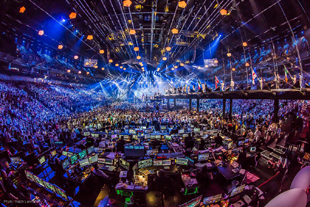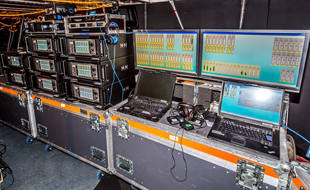![]() With more than 100m television viewers watching live in 44 countries, the 2013 Eurovision Song Contest took its particular mix of music, spectacle, camp and kitsch to Sweden.
With more than 100m television viewers watching live in 44 countries, the 2013 Eurovision Song Contest took its particular mix of music, spectacle, camp and kitsch to Sweden.
Here, the 26 finalists competing in the world’s most-watched non-sporting event were served by a typically ambitious broadcast set-up, including its biggest ever radio mic system.
Adding to its visibility, those unable to get a ticket for the shows or the rehearsals could visit an open-air stage, where the ESC artists fitted in live performances of their songs into their tight rehearsal schedule.
 Hosting the contest and also performing as a singer and dancer, Petra Mede made best use of a Sennheiser Digital 9000 microphone and 2000 Series in-ear monitors for the show, which took place in front of 11,000 spectators in the Malmö Arena.
Hosting the contest and also performing as a singer and dancer, Petra Mede made best use of a Sennheiser Digital 9000 microphone and 2000 Series in-ear monitors for the show, which took place in front of 11,000 spectators in the Malmö Arena.
Capturing the sounds and atmosphere of the contest – on-stage and off – requires an impressive operation. This, the 58th edition, used 96 microphone channels of Sennheiser’s 9000 Series, plus 28 wireless monitoring channels of the 2000 IEM Series with a total of 160 bodypack receivers. In all, 150 frequencies were coordinated for the microphone and monitoring requirements in arena and the ESC press centre.
Wired Sennheiser MKH 416 shotgun microphones were used to capture the atmosphere in the auditorium and the Green Room, where artists and delegation members waited for the voting results.
‘The RF quality was astonishing; not a glitch,’ says Oskar Johansson, who served as Head of Sound for the event. ‘The almost zero intermodulation makes it really easy to set up channel plans, just find a free frequency and use it. We had the best support from Jonas [Næsby] and his team and felt really safe with the whole set-up.’
RF specialist Jonas Næsby of Sennheiser Nordic was on site to lend any necessary support. For four weeks, ‘stage left’ was his workplace, which he shared with Frans Ebbesson, Mic #1 of the production team. They were responsible for monitoring and patching the microphone signals as well as for scanning the RF environment for potential outside interference.
Although 2013 didn’t feature the LED walls that have been used at past years’ contests, the show was no less spectacular or colourful. But for the RF wireless side, this meant a welcome reduction in interference: ‘The challenges encountered inside Malmö Arena were mainly due to its metal construction and due to the sum of all equipment operated in the hall, from HDMI converters to cameras, all of which laid a wideband noise over the entire arena,’ Næsby says. ‘Other local interference spikes made approx. 50MHz of spectrum unusable. However, the high selectivity and automatic calibration of the Digital 9000 antennas made set-up much easier than with conventional systems.’
 ‘A further challenge for frequency coordination were the TV towers,’ adds Ebbesson. ‘We not only had to plan with the Swedish channels but also the Danish ones – there’s just 30km of sea between Malmö and Copenhagen. It helped a lot that the Digital 9000 system does not require any calculation of intermodulation frequencies. The system is linear and does not generate these frequencies, so we could simply fit the mics into the allocated spectrum. That was very efficient. We split the microphone system into three different frequency bands, B2, B4 and B7.
‘A further challenge for frequency coordination were the TV towers,’ adds Ebbesson. ‘We not only had to plan with the Swedish channels but also the Danish ones – there’s just 30km of sea between Malmö and Copenhagen. It helped a lot that the Digital 9000 system does not require any calculation of intermodulation frequencies. The system is linear and does not generate these frequencies, so we could simply fit the mics into the allocated spectrum. That was very efficient. We split the microphone system into three different frequency bands, B2, B4 and B7.
‘I was really impressed with the reliability of the transmission. With a transmitter inside the arena it would have taken a Faraday cage to get an RF dropout. I’ve done several shows that were of a similar venue size and RF environment that simply did not work out as well as the 9000 system did for the ESC.’
‘As always with this type of event, we spent a lot of time in locating unauthorised users of wireless microphones,’ Næsby offers. ‘We made sure that all members of the press bringing video cameras to the Eurovision got clear instructions that they must not use wireless equipment and could lose their accreditation if they did. There were posters with the same message all over the arena and press centre. But still we caught several unauthorised ENG teams every day, who potentially could have interfered with either the rehearsals or the TV broadcasts. Luckily we managed to locate and stop them before they could cause any serious interference.’
The event’s Soundcheck Room again proved very useful – here, artists could test and fine-tune their in-ears so that only minute changes were required to get the optimum settings on stage.
 ‘We had a set-up with the same equipment as used on the main stage, 2000 Series IEMs and Digital 9000 mics,’ Næsby explains. ‘The separate room allowed the sound team to carry out a very personalised set-up. In most cases, the IEM sound was already perfect when the artists left the Soundcheck Room, so they could concentrate fully on the stage, the camera angles, their choreography…’
‘We had a set-up with the same equipment as used on the main stage, 2000 Series IEMs and Digital 9000 mics,’ Næsby explains. ‘The separate room allowed the sound team to carry out a very personalised set-up. In most cases, the IEM sound was already perfect when the artists left the Soundcheck Room, so they could concentrate fully on the stage, the camera angles, their choreography…’
The SR 2050 IEM transmitters and A 5000-CP antennas were located directly at the monitor position: ‘Thus the transmitters could :shoot: at the gate to the backstage area, and immediately gave the artists the confidence that everything was fine when they got ready for the stage,’ Næsby says.
In 2014, the contest will move to Sweden’s near neighbour, as Emmelie de Forest from Denmark won the contest with her song, ‘Only Teardrops’, beating Farid Mammadov (‘Hold Me’) for Azerbaijan into second and Ukraine’s Zlata Ognevich (‘Gravity’) into third place.
After winning the national finals through the audience vote, the 20-year old scored the highest number of points in the first semi-final, and won the grand final with a total of 281 points. Since her national final, she has signed a record contract and released her first solo album.
More: www.sennheiser.com